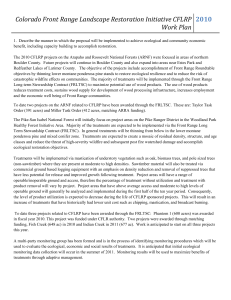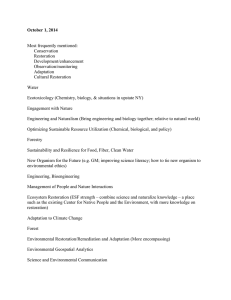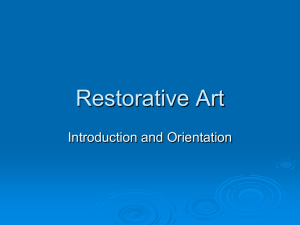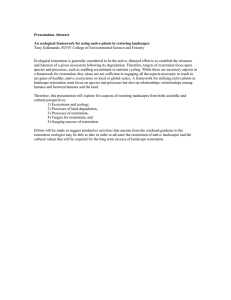CFLRP Work Plan- Dinkey Landscape Restoration Project 2010
advertisement
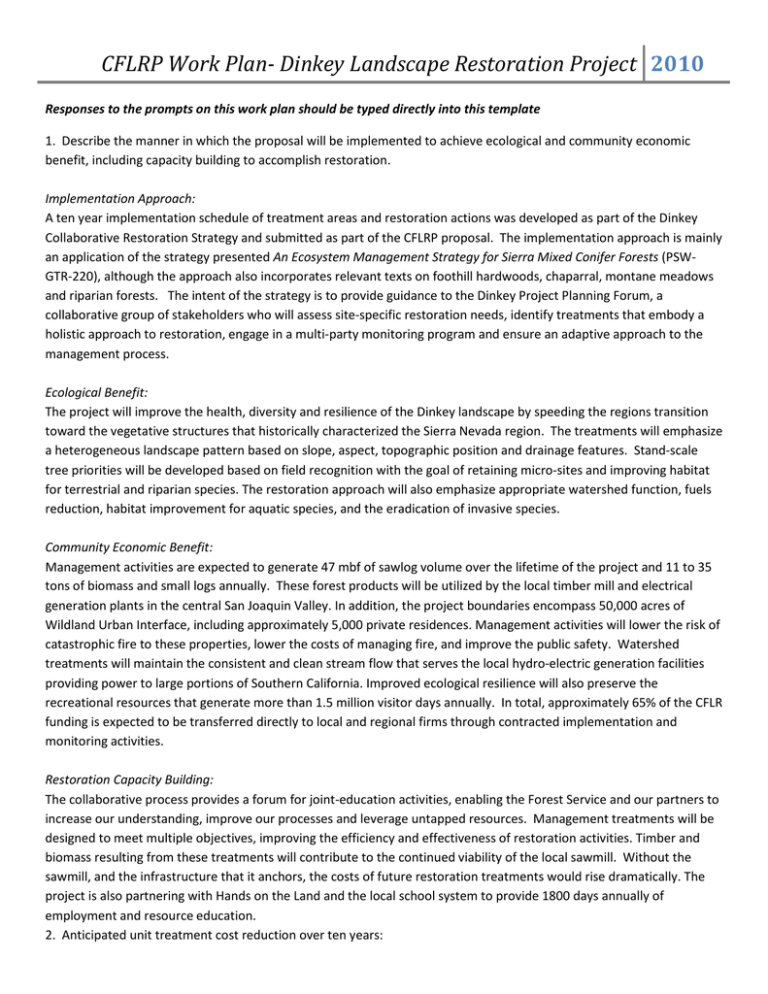
CFLRP Work Plan- Dinkey Landscape Restoration Project 2010 Responses to the prompts on this work plan should be typed directly into this template 1. Describe the manner in which the proposal will be implemented to achieve ecological and community economic benefit, including capacity building to accomplish restoration. Implementation Approach: A ten year implementation schedule of treatment areas and restoration actions was developed as part of the Dinkey Collaborative Restoration Strategy and submitted as part of the CFLRP proposal. The implementation approach is mainly an application of the strategy presented An Ecosystem Management Strategy for Sierra Mixed Conifer Forests (PSWGTR-220), although the approach also incorporates relevant texts on foothill hardwoods, chaparral, montane meadows and riparian forests. The intent of the strategy is to provide guidance to the Dinkey Project Planning Forum, a collaborative group of stakeholders who will assess site-specific restoration needs, identify treatments that embody a holistic approach to restoration, engage in a multi-party monitoring program and ensure an adaptive approach to the management process. Ecological Benefit: The project will improve the health, diversity and resilience of the Dinkey landscape by speeding the regions transition toward the vegetative structures that historically characterized the Sierra Nevada region. The treatments will emphasize a heterogeneous landscape pattern based on slope, aspect, topographic position and drainage features. Stand-scale tree priorities will be developed based on field recognition with the goal of retaining micro-sites and improving habitat for terrestrial and riparian species. The restoration approach will also emphasize appropriate watershed function, fuels reduction, habitat improvement for aquatic species, and the eradication of invasive species. Community Economic Benefit: Management activities are expected to generate 47 mbf of sawlog volume over the lifetime of the project and 11 to 35 tons of biomass and small logs annually. These forest products will be utilized by the local timber mill and electrical generation plants in the central San Joaquin Valley. In addition, the project boundaries encompass 50,000 acres of Wildland Urban Interface, including approximately 5,000 private residences. Management activities will lower the risk of catastrophic fire to these properties, lower the costs of managing fire, and improve the public safety. Watershed treatments will maintain the consistent and clean stream flow that serves the local hydro-electric generation facilities providing power to large portions of Southern California. Improved ecological resilience will also preserve the recreational resources that generate more than 1.5 million visitor days annually. In total, approximately 65% of the CFLR funding is expected to be transferred directly to local and regional firms through contracted implementation and monitoring activities. Restoration Capacity Building: The collaborative process provides a forum for joint-education activities, enabling the Forest Service and our partners to increase our understanding, improve our processes and leverage untapped resources. Management treatments will be designed to meet multiple objectives, improving the efficiency and effectiveness of restoration activities. Timber and biomass resulting from these treatments will contribute to the continued viability of the local sawmill. Without the sawmill, and the infrastructure that it anchors, the costs of future restoration treatments would rise dramatically. The project is also partnering with Hands on the Land and the local school system to provide 1800 days annually of employment and resource education. 2. Anticipated unit treatment cost reduction over ten years: CFLRP Work Plan- Dinkey Landscape Restoration Project 2010 Performance Measure Code Average Cost Historic Reduction Unit per Unit Cost FOR-VEG-EST $490 $80 FOR-VEG-IMP $130 $100 INVPLT-NXWD-FED-AC $200 $100 S&W-RSRC-IMP $5000 $0 HBT-ENH-STRM $3000 $0 RG-VEG-IMP $3 $0 RD-HC-MAIN RD-PC-MAINT RD-DECOM $250 $2395 $2000 $0 $0 $0 $235 $50 $40 $0 $400 $0 $1,600 $0 $200 $100 TMBR-SALES-TRT-AC TMBR-VOL-SLD FP-FUELS-NON-WUI FP-FUELS-WUI SP-INVSPE-FED-AC 3. Anticipated costs for infrastructure needed to implement project: Assumptions Reductions result from larger scale contracts The reduction assumes that the current biomass market will continue and that additional biomass processing will be cited on the Forest Cost savings assumes that invasive populations will be reduced, resulting in fewer treatment areas and less costly treatments in the future. Reductions may result from integrated accomplishment reporting, but the quantity is uncertain Reductions may result from integrated accomplishment reporting, but the quantity is uncertain Figure accounts only for planning costs, implementation costs are integrated into other management activities No cost reductions are expected No cost reductions are expected No cost reductions are expected Reduced unit cost assumes savings in less costly preparation and better economy of scale Cost reductions may result from larger scale contracts Costs based predominantly on prescribed fire Costs based predominantly on hand and mechanical treatments Cost savings assumes that invasive populations will be reduced, resulting in fewer treatment areas and less costly treatments in the future. CFLRP Work Plan- Dinkey Landscape Restoration Project 2010 Type of Infrastructure Anticipated Cost Funding Source (federal, private, etc) Curve straightening on NFS roads to allow heavy equipment access $10,000 Federal 4. Projected sustainability of the supply of woody biomass and small diameter trees removed in ecological restoration treatments: Fiscal Year 2010 2011 2012 2013 2014 2015 2016 2017 2018 2019 Number of acres to be treated 3030 600 7171 1602 5730 1700 8883 1800 5954 1200 Projected Green Tons Removed per Acre 360 920 1220 3930 4790 4450 4970 4970 1212 1212 Total Green Tons Available 1,090,800 552,000 8,748,600 6,295,900 27,446,700 7,565,000 4,4148,500 8,946,000 10,836,300 2,184,000 5. Projected local economic benefits: Type of projects Commercial Forest Products Other Project Activities TOTALS: Total direct jobs 9.3 25.3 34.6 Total indirect jobs 15.3 6.1 21.4 Total Direct Labor Income $503,105 $891,659 $1,394,763 Total Indirect Labor Income 1 $717,157 $309,239 $1,026,396 6. Document the non-Federal investment in the priority landscape: Source of Investment Southern California Edison Sierra Nevada Legacy Amount of Investment $220,000 $330,000 Description of Use Implementation and monitoring activities Implementation and monitoring activities 7. Plans to decommission any temporary roads established to carry out the proposal: 1 Values obtained from Treatment for Restoration Economic Analysis Tool (TREAT) spreadsheet, “Impacts-Jobs and Income” tab. Spreadsheet available at INSERT WEBSITE HERE CFLRP Work Plan- Dinkey Landscape Restoration Project 2010 Projected accomplishment year (fiscal) 2010 2011 2012 2013 2014 2015 2016 2017 2018 2019 Number of Miles to be Decommissioned 0 5.3 2 0 0 0 2 0 2 2

